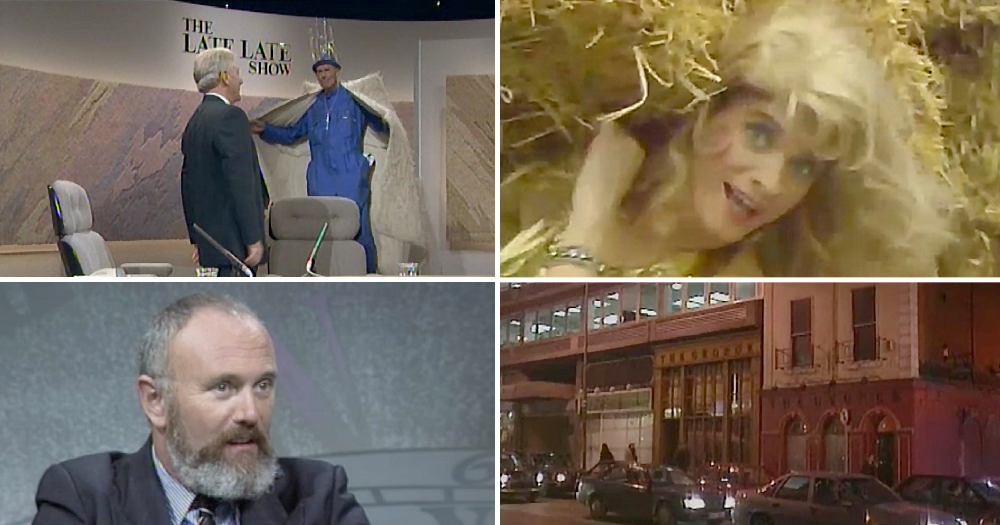Join us in another dish from the RTÉ archives as we take look at the decade that witnessed the decriminalisation of homosexuality, we hear more queer voices speaking up on their experiences living under shameful laws, more important discussions on HIV and a report on a potential LGBTQ+ quarter for the capital.
The ’90s. The decade that saw a rapid rise in technology; pop culture’s platform expanded as a result and so too did that of the the new generation of queer icons that would come to take over Irish television screens.
1. ‘Panti is Seán The Drag Queen Farmer’, 1990

A fresh-faced Panti Bliss graced Irish television screens back in 1990 in this sketch for RTÉ’s Nighthawks. In the clip, “Seán” is seen tending to the farm while stopping for a tea break and later dancing through a field full of cows. We love to see it.
CW: RTÉ have used a term considered to be outdated regarding trans identity in the title of this feature. For more information on terms and definitions on trans identity, visit TENI’s glossary here.
2. ‘Demand To Decriminalise Homosexuality’, 1992

RTÉ News visits GCN Towers in this special report from November 1992. Regular contributor and gay rights activist, Kieran Rose is featured in the clip discussing the urgency for decriminalisation.
“Nobody suspects that I am a criminal in this society,” Rose told RTÉ.
This came as the Taoiseach of the time, Albert Reynolds, had commented that homosexual law reform was low on his list of priorities. The European Court of Human Rights had warned the Irish government that the legislation to decriminalise homosexuality must be brought in within the next six months.
3. ‘What It Means To Be Gay In Ireland’, 1993

In this clip, Stephen Lewis appears on Prime Time to discuss what life is like for a gay person in Ireland in the year that homosexuality is decriminalised.
“Some people find it easier to see two men kill each other. It’s more acceptable. But if you see two men walking down the street holding hands or, for that matter, two women holding hands people are offended. I can’t understand that logic,” Lewis said.
Later in the clip, we see Senator David Norris arguing the case for gay rights with Fine Gael TD Brendan McGahon who is opposed to decriminalisation.
4. ‘Remembering The Diceman Thom McGinty’, 1994

Thom McGinty, better known as The Diceman, appeared on The Late Late Show in November 1994 to discuss his life, work and living with HIV. Thom had to retire from his performance work as he became ill. He comments on how the press of the time had been refusing to acknowledge his HIV status.
“I’ve been living with that for the last four years so this is the big mystery of the mysterious illness that’s being written about. They say, ‘He’s seriously ill’ – if it was meningitis or cancer they’d say, you know?”, he told host Gay Byrne.
Thom was born in Scotland and spent most of his life and career in Ireland where he became the country’s most celebrated street performance artist. The Diceman would dress in outrageous costumes, often advertising local businesses, and would silently parade around Dublin city to the delight of his audience. He died in February 1995.
5. ‘Gay And Lesbian Tourism’, 1998

Things were looking up by the end of the decade, in the years following decriminalisation, as talks around a potential LGBTQ+ quarter in Dublin were discussed in this RTÉ News report from January 1998.
In another feature from GCN (!), Brian Finnegan discusses the benefits of a dedicated LGBTQ+ quarter in the capital both for the city’s culture and economy. Anthony Murnane reports:
“The city’s gay community has been thriving in recent years. Magazine displays show the sheer number of gay and lesbian events taking place in any one week. And the value of the ‘pink pound’ is understood by big business.”
Tune in for the next in our series as we witness what the new millennium had to offer for Ireland’s LGBTQ+ community, as covered by the queer icons and stars of Irish TV and radio and preserved in the RTÉ archives.
You can always reel in the queers yourself by looking at our previous features in this series: The queer ’70s – ’80s here and the late ’80s archive here!
© 2021 GCN (Gay Community News). All rights reserved.
Support GCN
GCN is a free, vital resource for Ireland’s LGBTQ+ community since 1988.
GCN is a trading name of National LGBT Federation CLG, a registered charity - Charity Number: 20034580.
GCN relies on the generous support of the community and allies to sustain the crucial work that we do. Producing GCN is costly, and, in an industry which has been hugely impacted by rising costs, we need your support to help sustain and grow this vital resource.
Supporting GCN for as little as €1.99 per month will help us continue our work as Ireland’s free, independent LGBTQ+ media.

comments. Please sign in to comment.